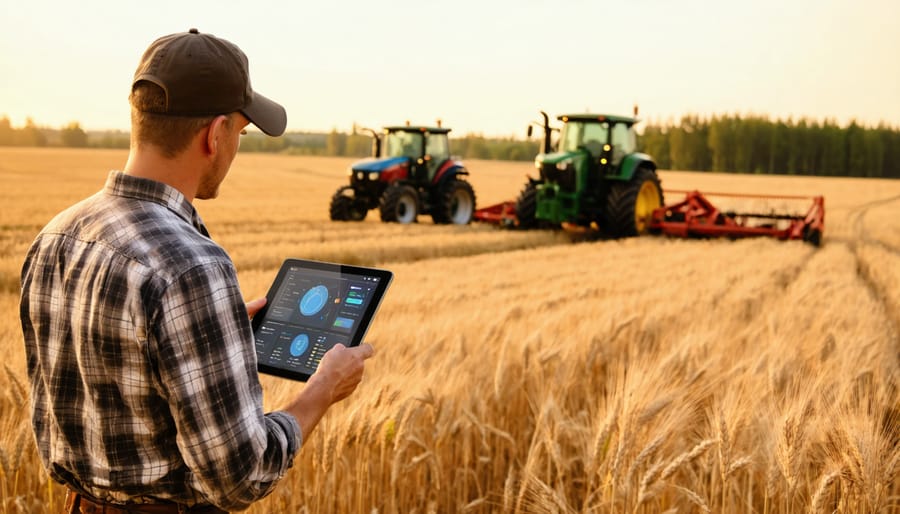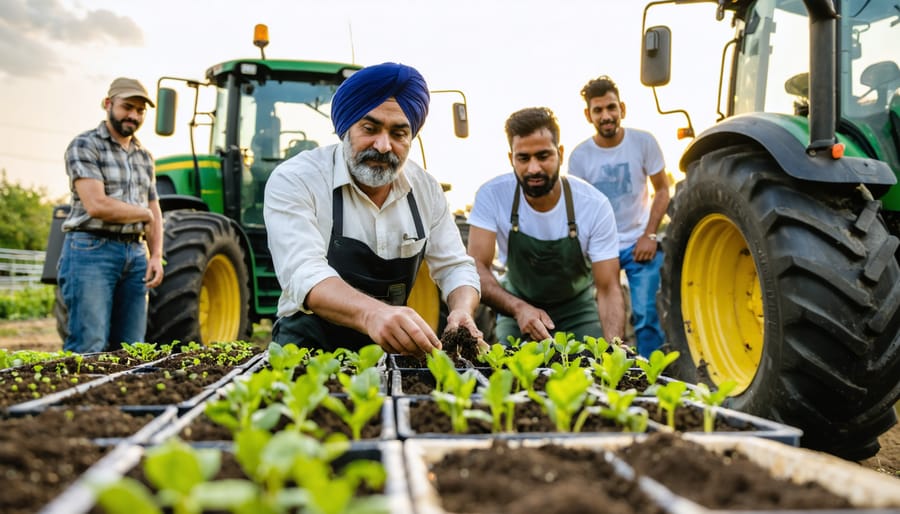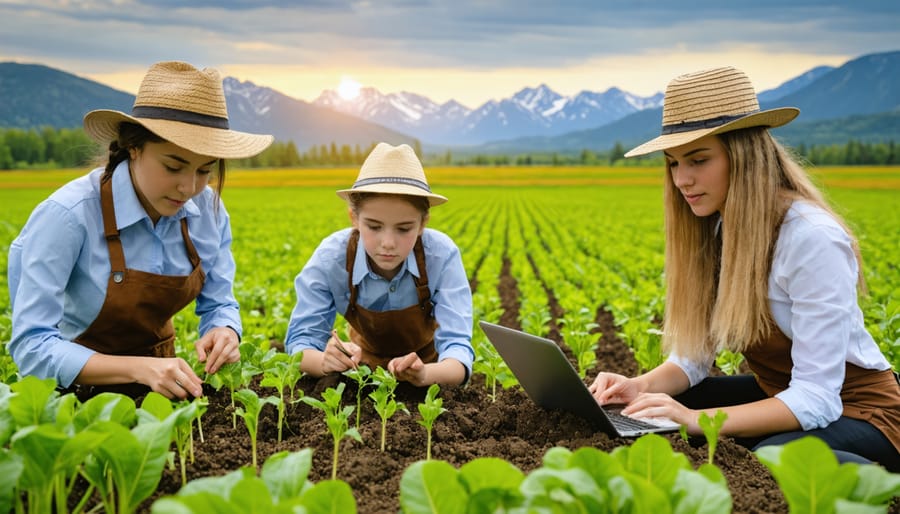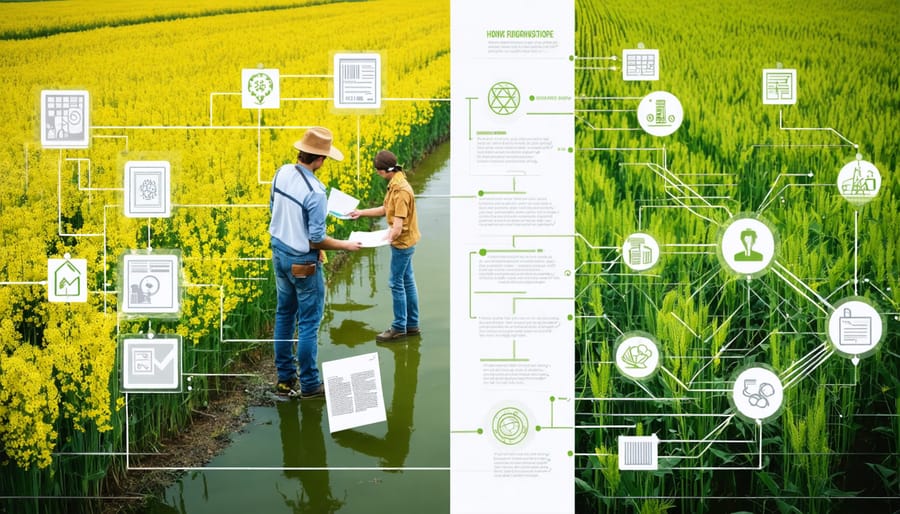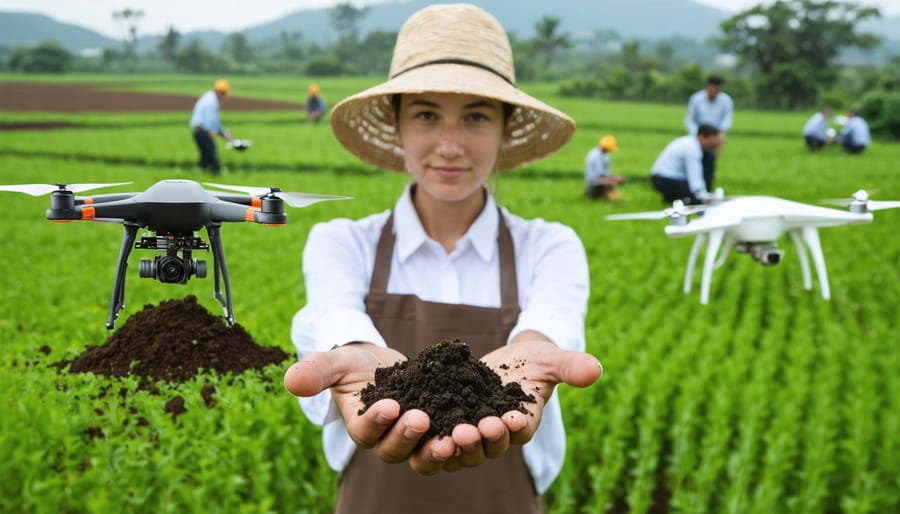Agricultural data analytics is revolutionizing Canadian farming, transforming traditional practices into precise, data-driven operations that boost yields while conserving resources. Across Alberta’s wheat fields and prairie farms, producers are harnessing the power of satellite imagery, soil sensors, and machine learning algorithms to make better decisions about everything from seeding rates to harvest timing.
The integration of big data analytics in agriculture has already demonstrated remarkable results: 15% average yield increases, 30% reduction in water usage, and up to 20% decrease in input costs for early adopters. For Canadian farmers facing increasingly unpredictable weather patterns and market pressures, these technologies offer a competitive edge in global markets while promoting sustainable farming practices.
Real-time data collection from field sensors, weather stations, and equipment telemetry now enables farmers to respond instantly to changing conditions, optimize resource allocation, and predict potential issues before they impact crop health. This shift from reactive to proactive farming represents more than just technological advancement – it’s a fundamental transformation in how we approach food production in the 21st century.
As precision agriculture continues to evolve, the ability to collect, analyze, and act on farm data has become as essential as traditional farming knowledge, creating a new paradigm where digital literacy and agricultural expertise work hand in hand to ensure farm sustainability and profitability.
The Power of Farm Data in Modern Agriculture
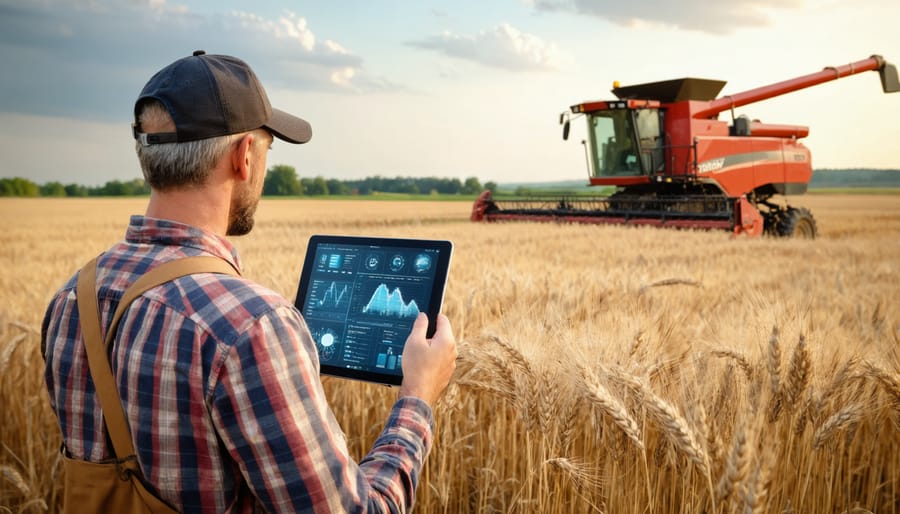
Key Data Types for Precision Farming
In modern precision farming, three key data types form the foundation of informed decision-making. First, soil health data encompasses nutrient levels, pH balance, organic matter content, and moisture retention. Here in Alberta, where soil conditions can vary significantly between regions, regular soil testing provides crucial insights for optimal fertilization and irrigation strategies.
Weather pattern data is equally vital, including precipitation levels, temperature variations, frost dates, and wind conditions. Many Alberta farmers now use local weather stations and satellite data to track these patterns, helping them anticipate and respond to changing conditions that affect their operations.
Crop yield data tells the story of your harvest success, tracking production volumes, quality metrics, and variations across different field sections. This information, when collected over multiple seasons, reveals patterns that help optimize planting decisions and resource allocation.
Additional data types gaining importance include equipment performance metrics, pest and disease surveillance data, and market trend information. When combined, these data sources create a comprehensive picture of your farming operation, enabling more precise and profitable farming practices.
Real-time Analytics Tools for Alberta Farmers
Alberta farmers now have access to several user-friendly digital agronomy tools that provide real-time insights for better decision-making. Popular platforms like FarmCommand and Climate FieldView have been adapted specifically for Alberta’s unique growing conditions, offering features like soil moisture tracking and frost alerts.
Local agricultural technology companies have developed mobile apps that integrate with weather stations and soil sensors, providing instant updates directly to farmers’ smartphones. These tools are particularly valuable during critical growing periods, allowing producers to monitor field conditions and make timely adjustments to irrigation and crop protection strategies.
The Alberta Federation of Agriculture has partnered with tech providers to offer subsidized access to these analytics platforms, making them more accessible to small and medium-sized operations. Free training workshops are regularly held across the province, helping farmers maximize the benefits of these tools.
Many of these platforms also facilitate data sharing among neighboring farms, creating valuable regional insights while maintaining individual privacy. This collaborative approach has helped establish benchmark data specific to different agricultural zones within Alberta.
Practical Applications in Alberta’s Fields
Success Story: Smart Irrigation in Southern Alberta
The Henderson family farm, located just outside of Lethbridge, Alberta, has been transforming their irrigation practices through data analytics since 2019. Sarah Henderson, a third-generation farmer managing 800 hectares of land, implemented smart irrigation sensors and analytics software to optimize water usage across their wheat and canola fields.
“Before implementing data analytics, we were essentially guessing about irrigation timing,” Sarah explains. “Now, we’re making decisions based on real-time soil moisture data and weather predictions.”
The farm installed 40 soil moisture sensors across their fields, connected to a central analytics platform that processes data every 15 minutes. The system integrates local weather forecasts, historical irrigation patterns, and crop-specific water requirements to generate precise irrigation schedules.
The results have been remarkable. In the first year alone, the Hendersons reduced their water consumption by 27% while maintaining crop yields. By the second year, they saw a 12% increase in yield efficiency, primarily due to more precise water distribution and reduced crop stress.
The system’s predictive analytics helped them avoid over-irrigation during an unusually wet spring in 2021, preventing potential root disease issues in their canola crop. The data also revealed that their western fields required 15% less irrigation than previously assumed, leading to significant water and energy savings.
“The initial investment was substantial,” Sarah admits, “but the water savings alone covered our costs within two seasons. More importantly, we’re farming more sustainably for the next generation.”
The Hendersons now share their data analytics experience with neighboring farms, contributing to a growing network of smart irrigation practitioners in Southern Alberta.
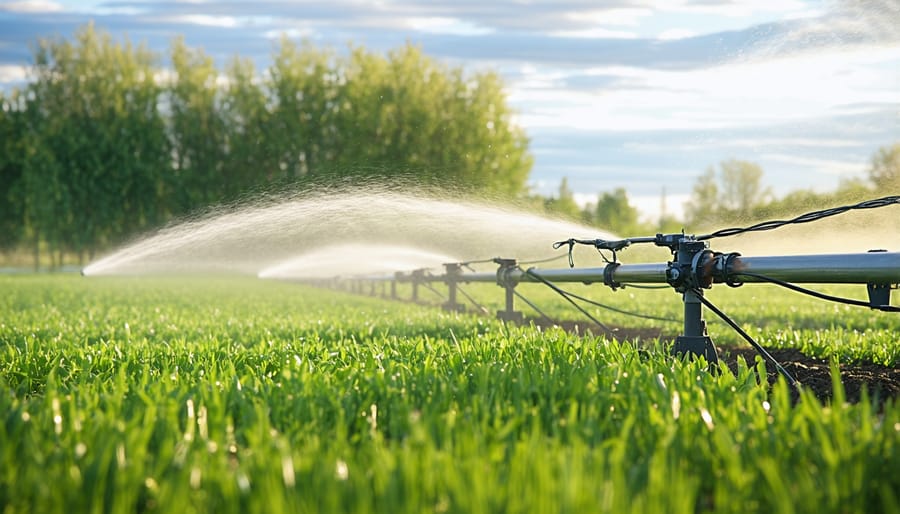
Precision Seeding Through Data-Driven Decisions
Local farmers across Alberta are revolutionizing their seeding practices through data analytics, achieving remarkable improvements in crop yield and resource efficiency. Take Roland Nielsen, a third-generation farmer from Olds, who increased his canola yield by 15% after implementing precision seeding based on soil moisture data and historical performance metrics.
Nielsen combines data from soil sensors, weather stations, and satellite imagery to determine optimal seeding depth and spacing for different areas of his fields. “The technology showed us that we were overseeding some areas while missing opportunities in others,” he explains. “Now we can adjust seed rates metre by metre across the field.”
The Alberta Data-Driven Agriculture Initiative reports that farmers using precision seeding analytics typically see a 10-20% reduction in seed costs while maintaining or improving yields. These systems analyze multiple data points, including:
– Soil composition and organic matter content
– Field elevation and drainage patterns
– Historical yield data
– Real-time soil moisture levels
– Local weather patterns and forecasts
Sarah Martinez, an agronomist from Red Deer, works with several farms implementing these systems. “We’re seeing farmers make more confident decisions about when to seed,” she notes. “The data tells us exactly which fields are ready and what adjustments we need to make for optimal germination.”
The investment in precision seeding technology typically pays for itself within two to three growing seasons. Modern systems can integrate with existing equipment through simple retrofitting, making this technology accessible to farms of various sizes and budgets. Many farmers start with basic soil moisture mapping and gradually expand their data collection as they see results.
Getting Started with Agricultural Analytics
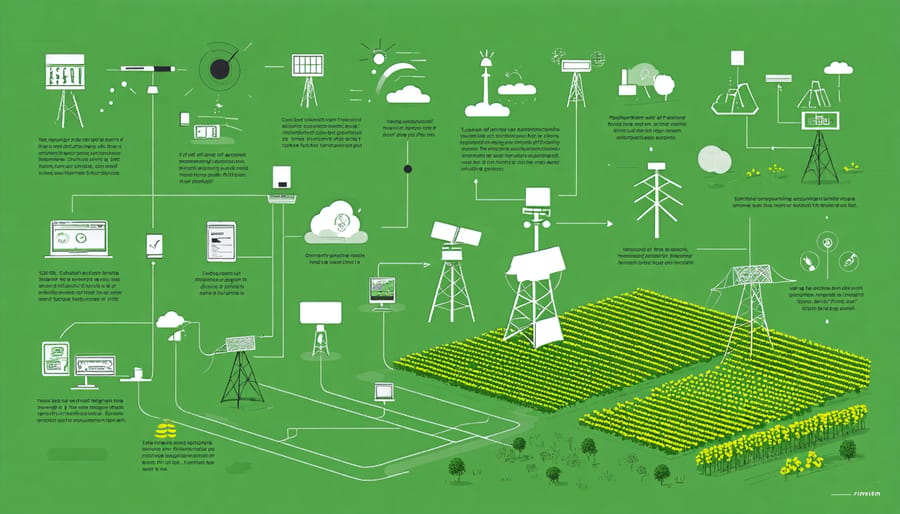
Essential Tools and Technologies
As Canadian agriculture embraces the digital agriculture revolution, having the right tools is essential for success in data analytics. The foundation starts with reliable soil sensors and weather stations, which typically cost between $500-2,000 CAD. These devices provide crucial information about moisture levels, temperature, and soil composition.
A GPS-enabled smartphone or tablet serves as your mobile command centre, allowing you to record and access data in the field. Most Alberta farmers find that standard smartphones with agricultural apps work well for basic data collection. Popular choices include Climate FieldView and Farmers Edge, which offer free basic versions to get started.
For mapping and field analysis, a basic drone with a standard camera (ranging from $1,500-3,000 CAD) can provide valuable aerial insights. However, many beginners start with satellite imagery services, which are more affordable and don’t require specialized training.
On the software side, farm management information systems (FMIS) are crucial. FarmCommand and AgriMap are well-suited for Canadian operations, with monthly subscriptions starting at around $100. These platforms help organize your data and generate actionable insights.
Don’t forget about reliable internet connectivity – consider a mobile hotspot or cellular signal booster for areas with weak coverage, especially common in rural Alberta.
Building Your Data Management Strategy
Building a robust data management strategy starts with identifying your farm’s specific needs and goals. Begin by listing your key production challenges – whether that’s optimizing irrigation, managing soil health, or improving yield predictions. This focused approach helps determine what data you’ll need to collect.
Create a systematic data collection schedule that aligns with your farming calendar. For instance, many Alberta farmers begin with basic soil testing in spring, followed by regular crop growth monitoring throughout the season. Consider investing in user-friendly tools like mobile apps for field observations and automated sensors for weather data.
Organize your data into clear categories: field operations, crop performance, weather patterns, and input costs. Use consistent naming conventions for your fields and crops to maintain order. Many successful Alberta operations use digital platforms that automatically sync field data with cloud storage, ensuring nothing gets lost.
Quality control is crucial – verify your data regularly and maintain detailed records of any unusual events or observations. When possible, cross-reference different data sources to validate your findings. For example, compare your yield maps with satellite imagery to spot patterns.
Start small and scale up gradually. Focus on mastering one aspect of data collection before adding more complexity. Remember, the goal isn’t to collect every possible data point, but to gather information that helps make better farming decisions.
Consider joining local farmer networks that share data management practices. Many Alberta producers have found success through collaborative learning and sharing experiences with neighbouring farms.
Environmental Benefits and Sustainability Impact
Reducing Carbon Footprint Through Smart Farming
Data-driven agriculture is revolutionizing how Canadian farmers approach environmental stewardship. By implementing climate-smart farming practices, Alberta’s farming community is significantly reducing its carbon footprint while maintaining productive operations.
Smart sensors and precision agriculture technologies enable farmers to optimize resource usage through accurate monitoring of soil conditions, weather patterns, and crop health. For instance, variable-rate technology allows for precise application of inputs, reducing both waste and emissions. Alberta farmers using these systems report up to 20% reduction in fertilizer use while maintaining yield levels.
Real-time data analytics help determine the ideal timing for field operations, minimizing unnecessary equipment passes and fuel consumption. Soil moisture sensors ensure irrigation is applied only when needed, reducing water waste and the energy required for pumping. Many local farmers have cut their irrigation-related energy costs by 15-30% through these innovations.
Carbon sequestration tracking through data analytics is also gaining traction. By monitoring soil organic matter levels and implementing targeted conservation practices, farmers can measure and improve their land’s carbon storage capacity. Several Alberta farms have successfully increased their soil organic carbon by 0.5-1% over five years using data-driven decision-making.
These sustainable practices not only benefit the environment but also contribute to farm efficiency and profitability, creating a win-win situation for both agriculture and climate action.
Soil Health Monitoring and Management
Modern farming success relies heavily on effective soil health monitoring through data analytics. Alberta farmers are increasingly using sensor networks and digital tools to track crucial soil parameters like organic matter content, nutrient levels, and moisture retention. These systems collect real-time data that helps make informed decisions about field management.
By analyzing soil data trends over multiple growing seasons, farmers can identify areas requiring attention and optimize their inputs. For instance, Prairie farmers using soil analytics have reported up to 20% reduction in fertilizer costs while maintaining or improving yields through precise nutrient management.
Smart soil monitoring systems can alert farmers to potential issues before they become visible problems. Continuous pH monitoring, electrical conductivity measurements, and biological activity assessments provide a comprehensive picture of soil health. This data helps farmers time their interventions perfectly, whether it’s adding amendments, adjusting irrigation, or planning crop rotations.
Many Alberta producers are now combining soil data with weather forecasts and crop performance metrics to create detailed field management zones. This integration allows for variable-rate application of inputs and better resource allocation. Local success stories include farms that have improved their soil organic matter by 2% over five years through data-driven management decisions.
Regular soil analysis and tracking through digital platforms also supports compliance with environmental standards while building long-term soil fertility. This approach ensures sustainable farming practices that benefit both current operations and future generations.
Agricultural data analytics has proven to be a game-changer for Canadian farming operations, offering tangible benefits that extend far beyond basic crop monitoring. From our Alberta fields to nationwide operations, farmers who have embraced these technologies report significant improvements in yield optimization, resource efficiency, and overall farm profitability.
The evidence is clear: farms utilizing data analytics typically see reduced input costs of 15-20% while maintaining or improving production levels. These tools have become especially valuable in our prairie provinces, where weather patterns and soil conditions can change dramatically from one season to the next.
As we’ve seen throughout this discussion, the initial investment in agricultural data analytics pays dividends through better decision-making, reduced waste, and more sustainable farming practices. Whether you’re managing a small family farm or overseeing large-scale operations, these tools can be scaled to meet your specific needs and budget.
For those who haven’t yet taken the plunge into data-driven farming, remember that you don’t have to transform your entire operation overnight. Start small, perhaps with basic soil mapping or yield monitoring, and gradually expand your data collection and analysis capabilities as you become more comfortable with the technology.
The future of Canadian agriculture is increasingly data-driven, and our farming community is well-positioned to lead this transformation. By embracing agricultural data analytics, we’re not just improving our own operations – we’re contributing to a more sustainable and productive agricultural sector for generations to come.

